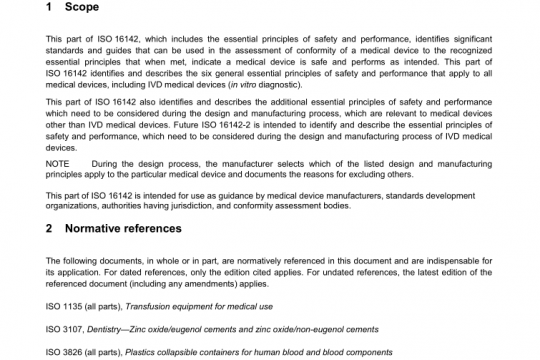AAMI TIR57 pdf free download
AAMI TIR57 pdf free download.Principles for medical device security—Risk management.
4 Security risk analysis 4.1 Security risk analysis process Security risk analysis should be performed for the medical device as described in 4.2 to 4.4. The results of the security risk analysis should be recorded in the security risk management file. Security needs to be assessed in the context of the larger system in which the device operates. The security risk analysis needs to consider the intended use and document the anticipated operating environment for which the device was designed and tested. The security architecture (see A.6) includes the complete operating environment of the device, as well as other important factors. These steps will facilitate communication to end user(s) responsible for device configuration. If a security risk analysis, or other relevant information, is available for a similar medical device, then that analysis or information can be used as a starting point for the new analysis. The degree of relevance depends on the differences between the devices and whether these introduce new risks or significant vulnerability differences. The extent of reuse should be based on a systematic evaluation of the effects the changes have on exposing the patients, users, and manufacturer to additional risks. In addition to the records recommended in 4.2 to 4.4, the documentation of the conduct and results of the security risk analysis should include at least the following: a) a description and identification of the medical device that was analyzed; b) identification of the person(s) and organization carrying out the security risk analysis; and c) scope and date(s) of the security risk analysis.4.2 Intended use and identification of characteristics related to the security of the medical device For the particular medical device being considered, the manufacturer should document the intended use and reasonably foreseeable misuse. Reasonably foreseeable misuse should include efforts that normal users might make to circumvent security controls when they are perceived as preventing their use of the device. NOTE 1 In this context, misuse is intended to mean incorrect or improper use of the medical device. NOTE 2 The exploration of potential malicious abuse by attackers will be accomplished during the threat analysis activity documented in 4.3. NOTE 3 Annex D contains questions that can serve as a useful guide in identifying medical device characteristics that could have an impact on security.The manufacturer should document the assumed operating environment and security architecture for which the device is designed to operate, along with any assumptions on external security controls that must be provided by the end user. This documentation should be maintained in the security risk management file. HDOs may have different and varying cybersecurity needs, risks and controls depending on the budget and sophistication of the organization. The manufacturer should perform a needs assessment with a representative sample of HDOs prior to initiating product design. The manufacturer should document characteristics of the system that rely on user configuration to ensure the security of the device. The device’s intended use and the experience level of the intended users should be understood to more accurately understand the likelihood of proper configuration by the end user. The risk analysis should address characteristics of the device and its expected operating environment (physical and IT). For example, the risk analysis should consider whether the device is mobile and/or expected to be physically accessible to unauthorized users. Interoperability requirements and constraints of the operating environment should also be considered and documented. For medical devices that use wireless technology with a discovery mode or similar active connection mode, the manufacturer should implement appropriate technical controls to prevent unauthorized users from sensing or connecting to the medical device. In some cases, a manufacturer may document recommended compensating controls for implementation in the user environment.AAMI TIR57 pdf download.
Other IEC Standards
-

ANSI AAMI ISO 16142-1 pdf free download – non-IVD medical devices and guidance on the selection of standards
AAMI standards list DOWNLOAD -

ANSI AAMI ISO 16142-2 pdf free download – General essential principles and additional specifc essential principles
AAMI standards list DOWNLOAD


